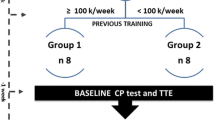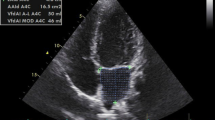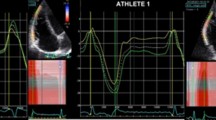Abstract
Purpose
Highly trained athletes have an increased risk of atrial arrhythmias. Atrial geometrical and functional remodeling may be the underlying substrate. We analyze and relate atrial size, deformation and performance in professional handball players compared with non-sportive subjects.
Methods
24 Professional handball players and 20 non-sportive males were compared. All subjects underwent an echocardiographic study with evaluation of left (LA), right atrial (RA) dimensions and deformation by strain (Sa) and strain rate (SRa). Atrial performance was assessed from the atrial stroke volume (SV). With computational geometrical models, we studied the relation between atrial volumes, strains and SV and compared atrial working conditions. We estimated the functional reserve and a resulting average wall stress.
Results
LA and RA volumes were larger in athletes than in controls (35.2 ± 8.8 vs. 24.8 ± 4.3 ml/m2, p < 0.01 and 29.0 ± 8.4 vs. 19.0 ± 5.1 ml/m2, p < 0.01 respectively). LASa and RASa during active atrial contraction were decreased in athletes (−12.2 ± 2.0 vs. −14.5 ± 2.1 %, p < 0.01 and −12.1 ± 1.8 vs. −14.2 ± 1.5 %, p < 0.01 respectively). LASV was similar between groups (6.6 ± 1.4 vs. 7.3 ± 1.1 ml, p = 0.19) and RASV was lower in athletes (6.2 ± 1.3 vs. 7.2 ± 1.1 ml, p < 0.01). Computational models showed that this different operational mode potentially increases performance reserve, but at the cost of higher atrial wall stress.
Conclusion
A proportion of athletes with enlarged LA and RA showed different atrial contractile performance, likely resulting in atria working at higher wall stress.




Similar content being viewed by others
Abbreviations
- AF:
-
Atrial fibrillation
- CMR:
-
Cardiac magnetic resonance
- LA:
-
Left atrium
- LASa:
-
Peak negative left atrial strain during active atrial contraction
- LASRa:
-
Peak negative left atrial strain rate during active atrial contraction
- LASRe:
-
LA early diastolic peak strain rate
- LASRs:
-
LA peak strain rate during ventricular systole
- LASs:
-
LA peak strain during ventricular systole
- LV:
-
Left ventricle
- RA:
-
Right atrium
- RASa:
-
Peak negative right atrial strain during active atrial contraction
- RASRa:
-
Peak negative right atrial strain rate during active atrial contraction
- RASRe:
-
RA early diastolic peak strain rate
- RASRs:
-
RA peak strain rate during ventricular systole
- RASs:
-
RA peak strain during ventricular systole
- RV:
-
Right ventricle
- SV:
-
Stroke volume
References
Abdulla J, Rokkedal J (2009) Is the risk of atrial fibrillation higher in athletes than in the general population? A systematic review and meta-analysis. Europace 11:1156–1159
Benito B, Gay-Jordi G, Serrano-Mollar A et al (2011) Cardiac arrhythmogenic remodeling in a rat model of long-term intensive exercise training. Circulation 123:13–22
Bijnens BH, Cikes M, Butakoff C, Sitges M, Crispi F (2012) Myocardial motion and deformation: what does it tell as and how does it relate to function? Fetal Diag Ther 32:5–16
D′Andrea Riegler L, Rucco MA et al (2013) Left atrial volume index in healthy subjects: clinical and echocardiographic correlates. Echocardiography 30:1001–1007
D′Andrea A, Riegler L, Cocchia R et al (2010) Left atrial volume index in highly trained athletes. Am Heart J 159:1155–1161
Di Martino E, Bellini C, Schwartzman D (2011) In vivo porcine left atrial wall stress: effect of ventricular tachypacing on spatial and temporal stress distribution. J Biomech 44:2755–2760
Elosua R, Arquer A, Mont L, García-Moran E, Brugada J, Marrugat J (2006) Sport practice and the risk of lone atrial fibrillation: a case control study. Int J Cardiol 108:332–337
Erol MK, Karakelleoglu S (2002) Assessment of right heart function in the athletes heart. Heart Vessels 16:175–180
Falsetti HL, Mates RE, Grant C, Greene DG, Bunnell IL (1970) Left ventricular wall stress calculated from one-plane cineangiography. Circ Res 26:71–83
Gabrielli L, Corbalan R, Córdova S et al (2011) Left atrial dysfunction is a predictor of postcoronary artery bypass atrial fibrillation: association of left atrial strain and strain rate assessed by speckle tracking. Echocardiography 28:1104–1108
Gabrielli L, Enríquez A, Córdova S, Yañez F, Godoy I, Corbalán R (2012) Assessment of left atrial function in hypertrophic cardiomyopathy and athlete′s heart: a left atrial myocardial deformation study. Echocardiography 29:943–949
Hoogsteen J, Schep G, Van Hemel NM, Van Der Wall EE (2004) Paroxysmal atrial fibrillation in male endurance athletes. A 9 years follow up. Europace 6:222–228
Hunter RJ, Liu Y, Lu Y, Wang W, Schilling RJ (2012) Left atrial wall stress distribution and its relationship to electrophysiologic remodeling in persistent atrial fibrillation. Circ Arrhythm Electrophysiol 5:351–360
Lang RM, Bierig M, Devereux RB et al (2006) Recommendations for chamber quantification. Eur J Echocardiogr 7:79–108
Marciniak A, Claus P, Sutherland GR et al (2007) Changes in systolic left ventricular function in isolated mitral regurgitation. A strain rate imaging study. Eur Heart J 28:2627–2636
Margreet A, Maass A, Oberdorf-Maass S, Van Veldhuisen D, Van Gilst W, Van Gelder I (2010) Mechanisms of atrial structural changes caused by stretch occurring before and during early atrial fibrillation. Cardiovasc Res 89:754–765
Mirsky I, Krayenbuehl HP (1981) The role of wall stress in the assessment of ventricular function. Herz 6:288–299
Molina L, Mont L, Marrugat J et al (2008) Long term endurance sport practice increases the incidence of lone atrial fibrillation in men: a follow up study. Europace 10:618–623
Padeletti M, Cameli M, Lisi M, Malandrino A, Zacá V, Montillo S (2012) Reference values of right atrial longitudinal strain imaging by two-dimensional speckle tracking. Echocardiography 29:147–152
Pelliccia A, Maron BJ, Di Paolo FM et al (2005) Prevalence and clinical significance of left atrial remodelling in competitive athletes. J Am Coll Cardiol 46:690–696
Prinz C, Van Buuren F, Bogunovic N, Bitter T, Faber L, Horstkotte D (2012) In patients with hypertrophic cardiomyopathy myocardial fibrosis is associated with both left ventricular and left atrial dysfunction. Acta Cardiol 67:187–193
Saraiva RM, Demirkol S, Buakhamsri A et al (2010) Left atrial strain measured by two-dimensional speckle tracking represents a new tool to evaluate left atrial function. J Am Soc Echocardiogr 2:172–180
Schneider C, Malisius R, Krause K, Bahlmann E, Boczor S (2008) Strain rate imaging for functional quantification of the left atrium: atrial deformation predicts the maintenance of sinus rhythm after catheter ablation of atrial fibrillation. Eur Heart J 20:1397–1409
Sitges M, Teijeira VA, Scalise A et al (2007) Is there an anatomical substrate for idiopathic paroxismal atrial fibrillation? A case control echocardiographic study. Europace 9:294–298
Sorokin AV, Araujo CG, Zweibel S, Thompson PD (2011) Atrial fibrillation in endurance-trained athletes. Br J Sports Med 45:185–188
Tsai CT, Tseng CD, Hwang JJ et al (2011) Tachycardia of atrial myocites induces collagen expression in atrial fibroblasts through transforming growth factor B1. Cardiovasc Res 89:805–815
Tsang MY, Barnes ME, Tsang TS (2012) Left atrial volume: clinical value revisited. Curr Cardiol Rep 14:374–380
Turagam M, Velagapudi P, Kocheril A (2012) Atrial fibrillation in athletes. Am J Cardiol 109:296–302
Van Buuren F, Mellwig KP, Faber L et al (2012) The occurrence of atrial fibrillation in former top-level handball players above the age of 50. Acta Cardiol 67:213–220
Wilhelm M, Roten L, Tanner H, Wilhelm I, Schmid JP, Saner H (2011) Atrial remodeling, autonomic tone and lifetime training hours in nonelite athletes. Am J Cardiol 108:580–585
Acknowledgments
This study was partially supported by Grants from the “Generalitat de Catalunya (Consell Catala de l’Esport)”, from “Grupo Memora (SFB-Grupo Memora)”, Spanish Society of Cardiology (Spanish Heart Foundation), from the “Plan Nacional I + D + I”, Spanish Government (DEP2010-20565), and from the “Subprograma de Proyectos en Salud”, Instituto de Salud Carlos III, Spanish Government (FIS—PI11/01709).
Conflict of interest
Authors have nothing to disclose.
Author information
Authors and Affiliations
Corresponding authors
Additional information
Communicated by Keith Phillip George.
Electronic supplementary material
Below is the link to the electronic supplementary material.
Rights and permissions
About this article
Cite this article
Gabrielli, L., Bijnens, B.H., Butakoff, C. et al. Atrial functional and geometrical remodeling in highly trained male athletes: for better or worse?. Eur J Appl Physiol 114, 1143–1152 (2014). https://doi.org/10.1007/s00421-014-2845-6
Received:
Accepted:
Published:
Issue Date:
DOI: https://doi.org/10.1007/s00421-014-2845-6




